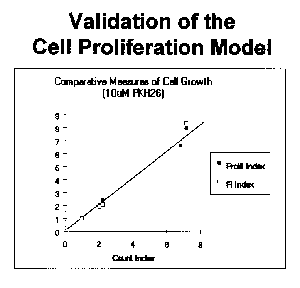      
|
      
|
An alternative model using 3-(4,5-dimethylthiazol-2-yl)-2, 5-diphenyltetrazolium bromide (MTT) as a dye provides a more accurate reflection of proliferating activity,1-6 but suffers from the inability to distinguish the proliferative activities of subsets of cells within the total population.
The Cell Census PlusTM System overcomes these limitations.
| ||||||||||||||||||||||||||||||||||||||||||||||||||||||||||
Human peripheral blood mononuclear cells from 11 normal donors were labeled with 2 µM PKH26 dye. An aliquot of each was fixed and saved for analysis as the day zero control. The rest of the labeled cells were placed in culture with 3 µg/ml PHA for 4 days. For the 3H-thymidine assay, aliquots of cultures were removed on day 4 and pulsed overnight. The data is given as CPM incorporated. The background incorporation in cultures incubated with media alone was uniformly less than 2,000 CPM for all donors. An aliquot of cultured cells from each donor was removed for measurement of proliferation by PKH26 fluorescence using flow cytometry. The flow cytometry data is presented as proliferation index (PI) calculated using Cell Census Plus and proliferation potential (PP).7

(Data contributed by Y. Yamamura, Ph.D., Ponce School of Medicine, Puerto Rico.)
| ||||||||||||||||||||||||||||||||||||||||||||||||||||||||||||

Figure 2. |
| Main Menu
| Online
Catalog | Technical Library
| Fields
of Interest |
| What's
New | On-line Ordering
| Sigma
Service | Site Index
|
![]()